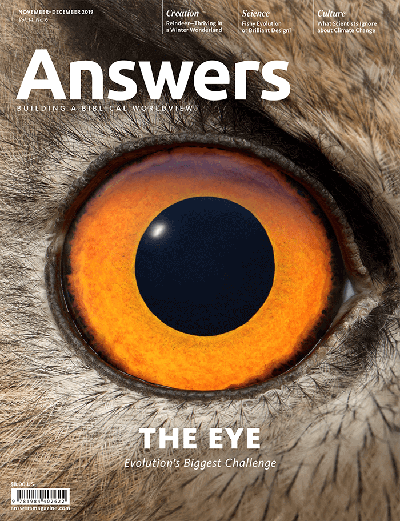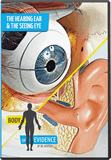An Eye for Every Occasion
Don’t look now, but you’re being watched by an amazing variety of magnificent eyes.
If you walk through the forest at dusk, literally thousands of eyes will follow your every move. Insects, amphibians, reptiles, mammals, and birds of all shapes and sizes will be aware of your presence, even if you remain blissfully ignorant of theirs.
That may sound creepy until you remember that God made them this way for their good. Life requires creatures to be aware of their surroundings so they can respond appropriately. However, creatures don’t see the world the same way we do—and for good reason. A slug on a stump doesn’t need our full-color, wide-angle, focused sight, which can track wind blowing through another person’s hair or a grin lighting up someone’s face.
Each creature has its own specially designed vision system to sense the world in just the way it needs. For instance, your eyes are wonderfully designed. Humans can see 10 million colors and detect changes in hues a few nanometers (billionths of a meter) apart. We can look up at the stars and then down at cells under a microscope without missing a beat. Our Creator gave us all we need to observe the world so we can fulfill our unique stewardship duties.

No two eyes have quite the same needs. Human eyes must adjust to any environment, from deep-sea dives to outer space. Other eyes are specifically designed for very special environments—high altitudes, freshwater lakes, saltwater, nighttime, daytime, and even underground. Each setting requires radically different optics.
The size of eyes ranges from microscopic to enormous. Tiny animals like worms don’t need huge eyeballs like those of elephants or whales; they only need tiny eyes that simply detect light or dark. In fact, their light sensors can only be seen with a powerful microscope. These sensors allow them to devote most of their energy and body to gathering soil and digesting waste.
Some insects have eyes less than one hundredth of an inch (0.1 mm) in diameter, whereas the giant squid, which scours the dark ocean depths looking for the slightest sign of life, has massive eyes up to the size of large dinner plates (11 inches, or 270 mm, in diameter)!
Seeing the World Through a Different Lens
Do you ever wonder why house cats and snakes have slits in their eyes, but beagles and cows do not? So do biologists. Recent studies are uncovering new reasons for these varied designs.
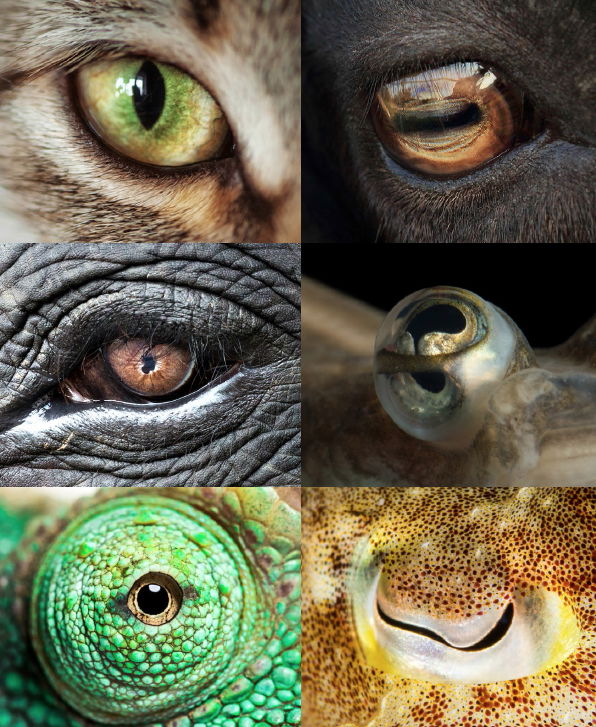
Vertical Slits: Small cats and other animals with vertical slits are usually small predators that need to see single prey with pinpoint accuracy. Horizontal Slits: Animals like goats with horizontal slits are small prey that need to watch for predators all around. Round Pupils: Slits help animals only if they are small and low to the ground. Elephants and other taller animals, whether predator or prey, do best with round pupils. Dual Pupils: The four-eyed fish, which lives in the brackish water of Central and South America, literally has two pupils in each eye. It floats on the surface, with one pupil in the air and the other underwater. (photo © Joel Sartore) Mobile Pupils: Chameleon eyes can move independently to allow nearly 360° vision without the animal moving and alerting prey or predators. Two-Focus Pupils: The oddly shaped pupil of a cuttlefish helps it form two images at once, one from the front and the other from the back. Cuttlefish can also change the pupil's curve size to help gauge distances.
So what could possibly explain the origin of such a vast range of eye designs? Ancient people recognized that the origin of their eyes must be supernatural. The wisest man who ever lived, King Solomon, acknowledged what seems an obvious truth: “The hearing ear and the seeing eye, the Lord has made them both” (Proverbs 20:12).
But the rise of modern evolutionary beliefs has forced some scientists to find an alternative explanation. They claim that eyes gradually evolved by chance over vast periods of time. Charles Darwin, who first proposed evolution by natural selection in 1859, hoped that future research would show that eyes had evolved from “simple and imperfect” designs to “complex and perfect” designs after thousands of small changes.1
Ever since then, evolutionists have searched for a series of simple eye designs that become increasingly complicated, reflecting this supposed history of slow development.
Modern science has succeeded in finding a series of eye designs that are far more complex and varied than Darwin could ever have imagined.
Modern science has succeeded in finding a series of eye designs. However, they are far more complex and varied than Darwin could ever have imagined. There is also a major problem for evolution. None of these eye designs are “imperfect” or “simple.” They all impeccably suit their purpose, as though they were designed that way from the beginning.
Types of Vision Systems
Despite the astonishing differences among eyes, experts have attempted to classify them into a few broad types with many variations. Evolutionists claim that the different vision systems with varying levels of sophistication support the idea that eyes evolved from simple to complex.
But such a claim is completely wrong for two reasons. First, none of the types are simple, so this does not help to explain the ultimate origin of vision systems. Second, there are major differences between the main types, so it does not explain how one vision system could have evolved into another type.
An alternative paradigm can fully explain this range of sophisticated vision systems: different needs of different organisms in different environments. Instead of linking all eyes to a common ancestor, we can see this diversity as evidence of a common Designer who filled his creation with similar but not identical vision systems that display a full spectrum of designs suited for varied needs.
Each type of vision system—from the earthworm’s simple light detectors to the eagle’s complex lenses—performs well in its respective way.
It is incorrect to say that any particular design is imperfect or primitive. Each type of vision system—from the earthworm’s simple light detectors to the eagle’s complex lenses—performs well in its respective way.
In fact, human engineers use all four main types of designs in different situations (from simple light triggers, called photodiodes, to complex lens cameras). This demonstrates that none of the types are a bad design. They just have different purposes.
Let’s look more closely at eye designs that use the four main types of vision systems: light sensor, chamber with no lens, compound eyes, and chamber with lens.
Light Sensor
Worms look simple from the outside, but they are actually a marvel of sophisticated design. They breathe through their skin, and their blood vessels pump cold blood through their body. They also have two tubes of muscle in two layers that give them a powerful burrowing ability.
Because worms usually must stay in the soil to survive, they need to sense light to ensure they remain underground. To do this, they have thousands of light-detecting photoreceptors all over their body on nerve endings, which tell them when they are near or on the surface.
If you look up eye evolution in a typical secular biology book, it will claim that single photoreceptors were the first stage in the eye’s evolution and that they just appeared by chance. However, photoreceptors are extremely sophisticated biochemical machines that could not possibly have just appeared by a series of accidents.
To illustrate this point, see if you can skim the following simplified summary of how a photoreceptor works without your eyes glazing over with all the technical terms and concepts. (The details truly are fascinating, once you get the advanced biology degree necessary to understand them.)
The visual cycle [of a photoreceptor] is the biological conversion of a photon into an electrical signal. . . . This process occurs via G-protein coupled receptors called opsins which contain the chromophore 11-cis retinal. 11-cis retinal is covalently linked to the opsin receptor via Schiff base forming retinylidene protein. When struck by a photon, 11-cis retinal undergoes photoisomerization to all-trans retinal which changes the conformation of the opsin GPCR leading to signal transduction cascades which causes closure of cyclic GMP-gated cation channel, and hyperpolarization of the photoreceptor cell.2
Sound complicated? The above is only part of the process. Another complex process is required to recharge the photoreceptor and get it ready to be activated again. You can’t keep the receptor running unless the recharge system is also in place.
So a single photoreceptor cell is a prime example of what is known as irreducible complexity. Many elements are needed simultaneously in a precise assembly to make the whole machine possible. One of the most complex parts of the photoreceptor is the protein opsin, which consists of chains of organic compounds that fold into precise three-dimensional shapes designed to interact with other structures in the cell. Such structures and interactions do not happen by chance.
But it gets even more challenging for the evolutionist because it turns out that some worms happen to have more complex photoreceptors than mammals. And these sensors are so superbly designed that they are inspiring new technology.
In 2016, a team of scientists at the University of Michigan discovered a new type of photoreceptor in roundworms that is about 50 times more efficient at capturing light than the photoreceptor in the human eye. Scientists are studying the new receptor protein with the hope of producing better sunscreens.3
Photoreceptors are so complex that George Wald received the Nobel Prize in 1967 for describing the process. That should make it pretty obvious that evolutionists cannot logically start an explanation of eye evolution by assuming photoreceptors existed at the beginning of the supposed evolutionary process.
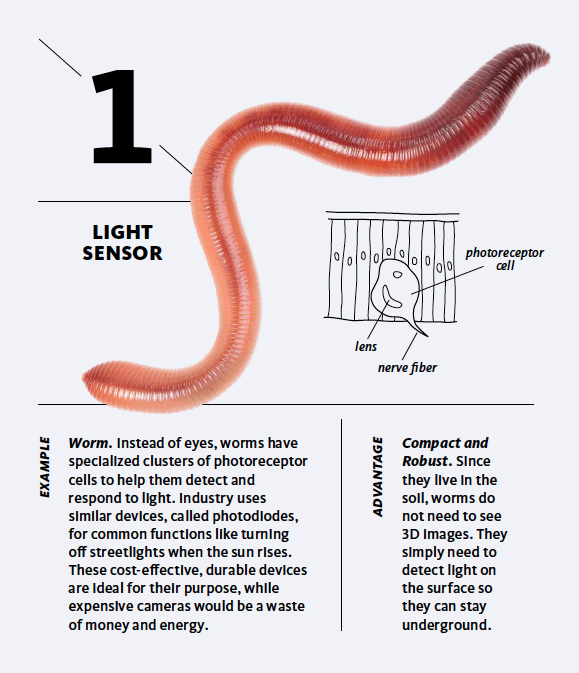
Example: Worm. Instead of eyes, worms have
specialized clusters of photoreceptor
cells to help them detect and
respond to light. Industry uses
similar devices, called photodiodes,
for common functions like turning
off streetlights when the sun rises.
These cost-effective, durable devices
are ideal for their purpose, while
expensive cameras would be a waste
of money and energy.
Advantage: Compact and
Robust. Since
they live in the
soil, worms do
not need to see
3D images. They
simply need to
detect light on
the surface so
they can stay
underground.
Chamber with No Lens
The nautilus is a beautiful marine mollusk that inhabits coral reefs in tropical waters from the Indian Ocean to the Pacific Ocean.
The nautilus has a chambered eye with no lens. Chambered simply means it has a container of some sort. Instead of passing through a lens at the front of the eye, the light is focused through a tiny pinhole opening that has to be just the right size and in the right position for the vision system to work.
Popular descriptions of the nautilus claim that it has a “rudimentary” eye because it uses a pinhole rather than a lens. However, a pinhole camera is not rudimentary at all but requires precision just like a lens and has its own advantages that lenses do not.
A pinhole camera has some advantages, such as a large depth of field, a wide angular field, and freedom from any linear distortion (unlike lenses). These features can be advantageous in a crowded place—like a coral reef.
Opticians use pinholes for eye tests. This shows that the design is good for certain circumstances. The fact that photographers today sometimes select the pinhole camera to obtain certain images is evidence that the pinhole is not an inferior design.

Example: Nautilus. The eyes of
undersea mollusks,
such as the nautilus,
have a round chamber
but no lens. Instead,
the light passes
through a tiny pinhole.
Focusing the light
as it passes through
the pinhole requires
precise design, like
eyes with lenses.
So it is not a simple
“rudimentary” step to
more complex eyes.
Advantage: Large Field of View.
A pinhole gives the
mollusk a large depth
of field and a wide
angular field. It also
eliminates linear
distortion caused by
lenses. These features
are advantageous in a
crowded coral reef.
Compound Eyes
When you look quickly at a dragonfly, it might appear to have two eyes. However, if you look closer, it actually has something like 30,000 separate eyes. These tiny individual eyes are called ommatidia and are grouped into two patches called compound eyes. Incredibly, each tiny ommatidium consists of its own cornea, lens, and photoreceptor cells, which distinguish brightness and color on their own.
Compound eyes point in different directions so an insect can see many areas at once without moving its eye. That is a useful tool when you are vulnerable to attack. Another feature is a fast response time to movement. The fruit fly’s reaction time is five thousandth of a second. That helps explain why it is so hard to swat a fly.
Some insects do not have compound eyes but simpler eyes called ocelli—photoreceptors which detect only movement. Ocelli can detect lower light levels and have a faster response time, while compound eyes are better at detecting details. It all depends on the needs of the different insects.
Some insects have both compound eyes and ocelli. Other insects, such as bees, can even detect polarization of light—which means they can detect the position of the sun on cloudy days so their work never stops.
The sophisticated vision systems packed into tiny insects bear testimony to a great Designer.
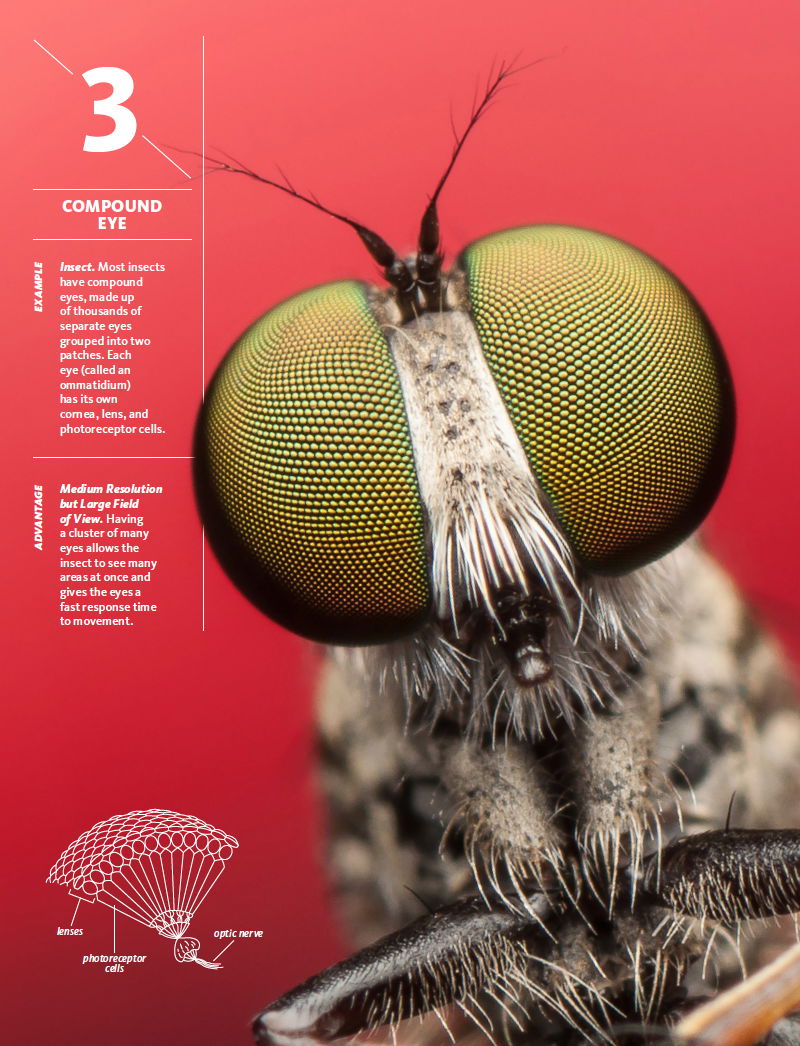
Example: Insect. Most insects
have compound
eyes, made up
of thousands of
separate eyes
grouped into two
patches. Each
eye (called an
ommatidium)
has its own
cornea, lens, and
photoreceptor cells.
Advantage: Medium Resolution
but Large Field
of View. Having
a cluster of many
eyes allows the
insect to see many
areas at once and
gives the eyes a
fast response time
to movement.
Chamber with Lens
An eagle’s eyesight is so powerful it can spot a rabbit moving two miles away. In fact, an eagle could be described as a pair of eyes with wings!
Eagle eyes are similar in principle to human eyes and the eyes of most vertebrates (animals with backbones): they all have a lens, an eyeball, and a retina. However, God has varied this basic design for each vertebrate’s special purpose. Eagle eyes are optimized to give the eagle super powerful eyesight appropriate to living the high life.
An eagle’s eyes take up more space than its brain. Eagles have a very large number of light sensitive cells, especially in what is called the fovea area, where focusing takes place. The eagle’s brain is also highly dedicated to the eyes, with an estimated 80% of an eagle’s sensory input coming from its eyes.
The fact that the eagle’s body is focused on expert vision makes complete sense considering that its main aim in life is to locate prey by sight.

Example: Eagle. All vertebrates
have rounded eyes
with a lens to focus
the light, similar
to man-made lens
cameras. This basic
design can have
endless variations,
depending on
the animal’s
needs. Eagles, for
example, have more
photoreceptor cells
in the back of the eye,
giving them as much
as eight times better
sight than humans
to detect mice over a
mile (2 km) away.
Advantage: High Resolution.
Focusing light
with a lens allows
vertebrates to
create sharp images
and detect a single
photon of light. With
their relatively large
brains to process
sensory information,
vertebrates can
gather maximum
information to make
the best possible
response to their
environment.
Eyes to See
The great diversity of eye designs is not a product of evolution but rather the result of an all-seeing Creator designing the most appropriate eye for every situation and occasion.
Any engineer who has ever worked on imaging instruments will tell you that the systems do not appear by chance. Yet nothing that engineers have produced begins to compare with what God has designed.4
When you consider the amazing design of eyes in creation and then consider how eyes grow in the womb, or when you consider how the eye can repair and maintain itself for a lifetime, you have to agree with Solomon that there is only one option: the existence of a Creator who is perfect in knowledge and skill.
"The hearing ear and the seeing eye, the Lord has made them both" (Proverbs 20:12).
Related Videos
The Hearing Ear and the Seeing Eye (Excerpt)
Answers Magazine
November–December 2019
Don’t look now, but you’re being watched by an amazing variety of magnificent eyes.
Browse Issue SubscribeFootnotes
- Charles Darwin, The Origin of Species by Means of Natural Selection or The Preservation of Favored Races in the Struggle for Life (The Modern Library, 1993), p. 227.
- “Visual Phototransduction," Wikipedia, https://en.wikipedia.org/wiki/Visual_phototransduction.
- “Tasting Light: New Type of Photoreceptor Is 50 Times More Efficient Than the Human Eye," University of Michigan, November 17, 2016, https://news.umich.edu/tasting-light-new-type-of-photoreceptor-is-50-times-more-efficient-than-the-human-eye/.
- In my line of work, I have designed parts of atomic force microscopes and imaging instruments for spacecraft. I know from experience that optical systems do not appear by chance. Thang Nguyen, Stuart Burgess, et al., “Estimation of the Shear Force in Transverse Dynamic Force Microscopy,” AIP (American Institute of Physics) Advances 5, no. 9 (2015).
Recommended Resources

Answers in Genesis is an apologetics ministry, dedicated to helping Christians defend their faith and proclaim the good news of Jesus Christ.
- Customer Service 800.778.3390
- © 2024 Answers in Genesis



